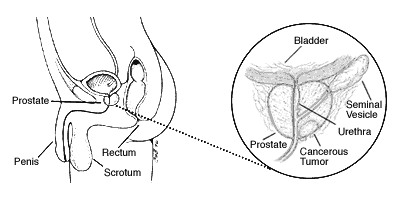|
The prostate is
a gland found only in men. As shown in the picture below, the
prostate is just below the bladder and in front of the rectum. It
is about the size of a walnut. The tube that carries urine (the
urethra) runs through the prostate. The prostate contains cells
that make some of the fluid (semen) that protects and nourishes
the sperm.

Prostate
Cancer
There are several types of cells in
the prostate, but nearly all prostate cancers start in the gland
cells. This kind of cancer is known as adenocarcinoma.
Most of the time, prostate cancer
grows slowly. Autopsy studies show that many older men (and even
younger men) who died of other diseases also had prostate cancer
that never caused a problem during their lives. These studies
showed that as many as 7 to 9 out of 10 men had prostate cancer by
age 80. But neither they nor their doctors even knew they had it.
Pre-cancerous changes of the prostate
Some doctors believe that prostate
cancer begins with very small changes in the size and shape of the
prostate gland cells. These changes are known as PIN (prostatic
intraepithelial neoplasia). Almost half of all men have PIN by the
time they reach age 50. In PIN, there are changes in how the
prostate gland cells look under the microscope, but the cells are
basically still in place -- they don't look like they've gone into
other parts of the prostate (like cancer cells would). These
changes can be either low-grade (almost normal) or high-grade
(abnormal).
If you have had a prostate biopsy
that showed high-grade PIN, there is a greater chance that there
are cancer cells in your prostate. For this reason, you will be
watched carefully and may need another biopsy.
|